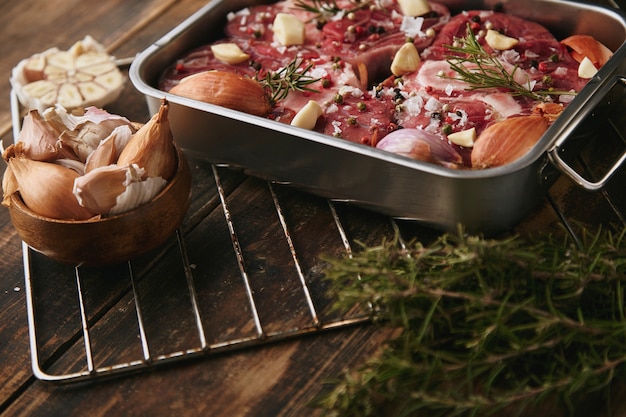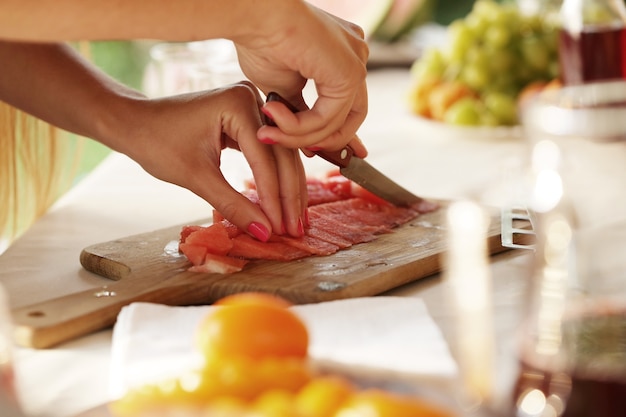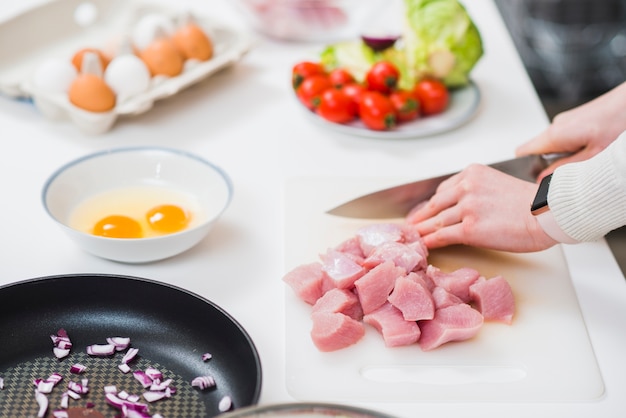Remember that time I tried to cook a ham for Christmas dinner? Let’s just say it wasn’t a festive success. Dry, bland, and a little bit rubbery – not exactly the centerpiece I was hoping for. But after a few years of trial and error (and some invaluable tips from my granny, bless her soul), I’ve finally cracked the code for a truly delicious, succulent ham. It’s a transformative experience, believe me. The aroma of a perfectly cooked ham wafting through the house is enough to make you want to dance. And when you see the smiles on everyone’s faces, you’ll feel like a culinary rockstar.
This guide is a no-nonsense, step-by-step roadmap to ham-cooking nirvana. Whether you’re a seasoned chef or a kitchen novice, you’ll find everything you need to transform a humble ham into a star-studded dish. We’ll delve into the intricacies of selecting the right ham, mastering various cooking methods, and creating a symphony of flavour with the right seasonings and glazes. So, put on your apron, grab a glass of something refreshing, and let’s get cooking!
Part 1: Choosing the perfect ham: The Foundation of a Delicious Feast

Navigating the Ham Hierarchy: A Guide to the Different Types
The first step is selecting the right ham, which sets the stage for a delicious and memorable meal. There’s a whole world of hams out there, each with its own unique characteristics. Let’s break them down so you can choose the one that sings to your soul:
- Fresh Ham: These are uncooked hams, usually with the bone still intact, that need to be cooked before you can enjoy them. They’re incredibly versatile and perfect for roasting, grilling, or braising. My personal favourite? Fresh ham. It’s like a blank canvas, allowing you to infuse it with your own seasonings and spices, creating a truly personalised masterpiece.
- cured ham: These hams have undergone a magical transformation, having been brined or dry-cured. The process gives them a salty, intensely flavoured profile that will leave you wanting more. They’re often already cooked and ready to eat, making them a convenient choice for a quick meal.
- smoked ham: Think of this as the “cured ham” that went on a flavour-infusing adventure. These hams have been cured and then smoked, adding a smoky depth to their flavour that’s utterly captivating. They can be either pre-cooked or uncooked, so make sure to check the label carefully.
The Bone-in vs. Boneless Debate: A Matter of Preference and Convenience
Now, you’ve got another decision to make: bone-in or boneless? This is a question of personal preference and convenience. bone-in hams are generally more flavourful, as the bone helps to retain moisture during cooking. They also hold their shape better, which is ideal for roasting, ensuring a beautiful presentation. boneless hams, on the other hand, are more convenient, easier to slice, and often come pre-sliced, perfect for a quick meal or a busy weeknight dinner.
Finding the Right Fit for You: A Journey of Personal Discovery
For me, there’s nothing quite like a traditional bone-in, fresh ham. It’s the ultimate blank canvas for flavour, allowing you to create a masterpiece tailored to your unique taste buds. But don’t feel pressured to follow my lead! Choose the ham that best suits your needs and preferences. Remember, it’s your kitchen, your rules.
Part 2: Preparing Your Ham: A Symphony of Flavour in the Making

Unveiling the Ham: A Ritual of Preparation
Before you can even think about cooking, you need to give your chosen ham a little TLC. For fresh hams, this involves removing the packaging and giving it a good rinse under cold water. Make sure you pat it dry with paper towels before proceeding. You don't want a soggy ham, do you? That's a recipe for disaster!
The Art of Scoring: Unveiling the Hidden Flavour
Scoring the ham, especially for bone-in hams, is an essential step in unlocking its full flavour potential. This involves making shallow cuts across the fat layer, about 1/2 inch deep. This allows the fat to render and crisp during cooking, enhancing the flavour and creating a beautiful, golden crust. A little tip from my granny: make sure you score the fat, not the meat itself. You don’t want to overcook the ham. We want a beautiful, juicy ham, not a dry and disappointing one.
Seasoning Secrets: Adding Your Personal Touch
Now, this is where the fun really begins! The seasoning possibilities are endless, allowing you to infuse your ham with a touch of your personality. Here are a few classic combinations that always get a nod of approval from my family:
- Classic Mustard and brown sugar glaze: A simple yet effective combo that adds a sweet and tangy touch. Mix Dijon mustard, brown sugar, and a splash of apple cider vinegar for a truly irresistible glaze. The sweetness of the brown sugar balances beautifully with the tang of the mustard, creating a symphony of flavour that will make your taste buds sing.
- Herb-Infused Delight: Embrace the power of herbs. Mix dried herbs like rosemary, thyme, and sage with olive oil and salt for a fragrant, savoury flavour. The rosemary adds a touch of earthy goodness, while the thyme brings a touch of lemony freshness, and the sage provides a warm, nutty flavour.
- Spicy Kick: For those who love a bit of heat, add a pinch of cayenne pepper or smoked paprika to your seasoning mix. Cayenne pepper adds a subtle heat that lingers on your tongue, while smoked paprika brings a smoky depth that complements the ham perfectly.
Remember, you can always experiment with your favourite spices and create a signature ham glaze! My personal touch is a hint of cinnamon, adding a subtle sweetness that complements the ham perfectly. It’s all about finding what you enjoy!
Part 3: Roasting Your Ham to Perfection: A Culinary Masterpiece in the Making

The Oven’s Embrace: A Symphony of Heat and Flavor
For a traditional roast, preheat your oven to 325°F (160°C). Place your ham on a roasting rack set in a large roasting pan. This allows for even cooking and prevents the ham from sitting in its own juices. You want a perfectly cooked ham, not a soggy one!
Timing is Everything: A Culinary Balancing Act
The cooking time for a ham depends on its size and whether it’s bone-in or boneless. As a general rule of thumb, allow about 15-20 minutes per pound of ham for bone-in, and about 12-15 minutes per pound for boneless. But remember, the best way to check for doneness is with a meat thermometer. Aim for an internal temperature of 145°F (63°C) for a safe and juicy ham.
The Glazing Ritual: A Touch of Sweetness and Shine
About 30 minutes before the ham is done, start basting it with your chosen glaze. This adds a beautiful sheen and flavour to the surface. If you’re feeling adventurous, you can create a glaze from scratch. My granny’s recipe involves a mixture of honey, brown sugar, maple syrup, and a touch of citrus zest for an unbelievably delicious glaze.
Part 4: Alternative Cooking Methods: Expanding Your Culinary Horizons
The Grill’s Embrace: A Smoky and Delicious Experience
If you’re a grilling enthusiast, there’s no reason why you can’t enjoy a delicious grilled ham. Simply preheat your grill to medium heat, and sear the ham on both sides until it develops a nice crust. Continue cooking, basting occasionally with your favourite glaze. Remember to keep an eye on the temperature to ensure it reaches 145°F (63°C).
slow cooker Serenity: A Hands-Off Approach to Culinary Delight
For a hands-off approach, the slow cooker is your new best friend. Place your ham in the slow cooker, surrounded by onions, carrots, and celery for added flavour. Pour in some chicken broth or apple cider for moisture, and cook on low for 6-8 hours. You can also add your glaze during the last hour of cooking for a final touch of sweetness.
The instant pot Revolution: A Quick and Easy Culinary Solution
For a quick and easy meal, the Instant Pot is a game changer. Place your ham in the Instant Pot with a cup of chicken broth or water. Cook on high pressure for 30-40 minutes for a bone-in ham, or 20-30 minutes for a boneless ham. You can then add your glaze and cook for an additional 5 minutes on low pressure.
Part 5: The Art of Carving: A Symphony of Precision and Skill
The Ultimate ham carving Guide: A Master Class in Precision
Once your ham is cooked to perfection, it’s time to carve it up. Here’s a step-by-step guide to ensure you get perfectly sliced ham:
- Let It Rest: Allow your ham to rest for 10-15 minutes after cooking. This allows the juices to redistribute, resulting in a more tender and juicy ham.
- Remove the Bone: If you’re dealing with a bone-in ham, use a sharp carving knife to carefully remove the bone. Be sure to save the bone for a delicious bone broth later.
- Slice and Dice: Start slicing your ham against the grain, cutting thin slices for sandwiches or thicker slices for serving on a platter.
Part 6: Ham-tastic side dishes: The Perfect Accompaniment to Your Culinary Masterpiece
A Feast for the Senses: A Culinary Ensemble of Flavors
A delicious ham deserves a stellar lineup of side dishes. Here are some classic pairings that always go down a treat:
- Creamy mashed potatoes: A timeless favourite, mashed potatoes provide a comforting counterpoint to the salty ham. The creaminess of the potatoes balances the richness of the ham, creating a harmonious culinary experience.
- green bean casserole: A classic holiday side dish, green bean casserole adds a touch of creaminess and crunch. The crispy fried onions provide a delightful textural contrast to the tender green beans, making this dish a real crowd-pleaser.
- Glazed Carrots: Sweet and tangy glazed carrots complement the ham perfectly. The sweetness of the glaze adds a touch of brightness, while the carrots provide a healthy and vibrant counterpoint to the richness of the ham.
- Honey-Glazed sweet potatoes: A touch of sweetness and spice, honey-glazed sweet potatoes add a delightful contrast to the savoury ham. The sweetness of the honey complements the savory flavors of the ham, creating a balanced and satisfying dish.
- Macaroni and Cheese: A cheesy, comforting side dish that is always a crowd-pleaser. The creamy, cheesy goodness of macaroni and cheese provides a comforting and satisfying complement to the ham.
Part 7: leftover ham Magic: Turning Culinary Leftovers into New Delights
From Dinner to Delightful: Transforming Leftovers into Culinary Treasures
Don't let those delicious ham leftovers go to waste! There’s a whole world of possibilities waiting to be explored. Here are some of my favourite ways to use leftover ham:
- ham and cheese sandwiches: A classic for a reason, ham and cheese sandwiches are a quick and easy lunch or snack. The salty ham pairs perfectly with the creamy cheese, creating a satisfying and flavourful sandwich.
- Ham and bean soup: A hearty and satisfying soup, perfect for a cold day. The ham adds a rich depth of flavour to the soup, while the beans provide a protein boost.
- Ham and broccoli quiche: A delicious and satisfying breakfast or brunch option. The ham adds a savory flavour to the quiche, while the broccoli provides a healthy and vibrant touch.
- Ham and Pineapple Pizza: A sweet and savory twist on the classic pizza. The salty ham and sweet pineapple create a delightful combination of flavors that will leave you wanting more.
Part 8: Ham-tastic Tips and Tricks: Unlocking the Secrets of the Pros
Unlocking the Secrets of the Pros: A Collection of Expert Tips and Tricks
Here’s a collection of my tried-and-true tips and tricks that have helped me achieve ham-cooking perfection:
- Don’t Overcook: Overcooked ham can be dry and tough. Cook it to the recommended internal temperature of 145°F (63°C), and then let it rest for 10-15 minutes before carving. This allows the juices to redistribute, resulting in a tender and juicy ham that will melt in your mouth.
- Baste, Baste, Baste: Basting your ham with glaze throughout the cooking process helps keep it moist and adds flavour. The glaze not only adds a beautiful sheen but also helps to lock in the moisture, preventing the ham from becoming dry.
- Go for Quality: A high-quality ham will make a world of difference in the taste and texture. Invest in a good quality ham and you'll be rewarded with a delicious and satisfying meal.
- Make it a Family Affair: Involving the family in the cooking process can create a fun and memorable experience. Let your kids help with the scoring or basting. They'll have a blast, and you'll create lasting memories.
- Experiment with Flavours: Don’t be afraid to experiment with different seasonings and glazes. The possibilities are endless! The beauty of cooking is that there are no limits. Let your creativity run wild and see what delicious combinations you can create.
Part 9: FAQs: A Comprehensive Guide to Your Ham-Cooking Questions
Here are some frequently asked questions about cooking ham, answered in a way that even a newbie can understand:
Q1: What’s the difference between a ham and a pork shoulder?
A ham comes from the hind leg of a pig, while a pork shoulder comes from the front shoulder. Hams are typically leaner and have a stronger flavour, while pork shoulders are more fatty and tender.
Q2: Can I freeze ham?
Yes, you can freeze ham. For the best results, freeze it before it’s cooked. Wrap it tightly in plastic wrap and aluminum foil before placing it in the freezer. Frozen ham can last for up to 2 months.
Q3: How do I reheat cooked ham?
You can reheat cooked ham in the oven, slow cooker, or microwave. Just make sure you heat it to an internal temperature of 145°F (63°C) for safety.
Q4: What are some creative ways to use leftover ham?
You can use leftover ham in sandwiches, salads, soups, pastas, and even pizzas. Get creative and experiment with different flavours and combinations.
Q5: Is there a difference between a “city ham” and a “country ham”?
Yes, there is. A city ham is typically cured with a brine, while a country ham is dry-cured. Country hams are known for their intense flavour and long shelf life. They are often served in slices or as a whole ham, while city hams are typically cooked and served in various ways.
So there you have it, my ultimate guide to cooking a delicious fresh ham. I hope you’ve enjoyed this journey from rookie to master. Remember, the key is to have fun, experiment with flavours, and most importantly, enjoy the process. Happy cooking!
Everyone is watching

How to Cook Frozen Lobster Tails Perfectly: A Step-by-Step Guide
RecipesLobster. Just the word conjures up images of lavish meals, special occasions, and a taste of luxury. But let's...

Pigs in a Blanket Cooking Time: How Long to Bake for Perfect Results
RecipesAh, pigs in a blanket. Just the name conjures up images of those delightful little parcels of crispy pastry en...

Pork Fillet Cooking Time: How Long to Cook It Perfectly
RecipesPork fillet, or tenderloin as it's sometimes called, is a real favourite in our house. It's so versatile, and...

The Ultimate Guide to Tender, Juicy Pulled Pork
RecipesRight, let's talk pulled pork. It's one of those dishes that just screams "comfort food," doesn't it? I mean...

The Ultimate Guide to Cooking Delicious Frankfurters
RecipesLet's face it, we all love a good frankfurter. It's a classic, simple, and always satisfying. But let's be rea...
